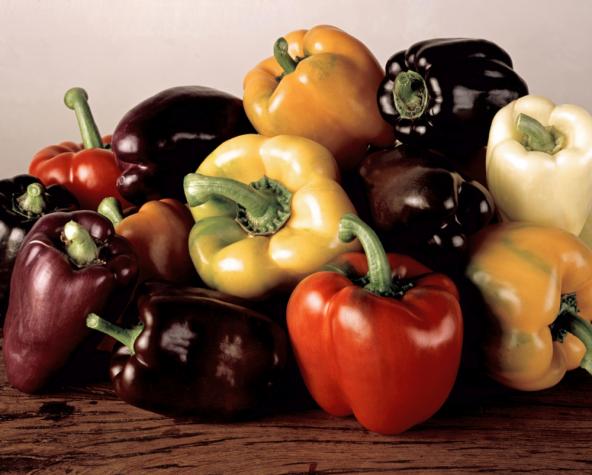COLUMBIA, Mo. – The colorful sweet pepper is the Christmas ornament of the vegetable garden, bearing fruit that ranges from red, orange, yellow and white to purple and chocolate black.
Growing
A member of the nightshade family, the sweet pepper is a relative of potato and tomato. Like its cousins, it is easy to establish if started using plants rather than seeds. It can’t tolerate cool weather, so wait until the danger of frost has past before planting.
“Sweet peppers need full sun, eight hours or more, and fertile, well-drained garden loam,” said David Trinklein, horticulture specialist for University of Missouri Extension. “Most varieties should be planted 18 to 20 inches apart within a row, and each row should be at least 24 inches apart.”
Sweet peppers are fairly heavy-feeding plants, so a soil test is important to determine which nutrients to add to your garden before planting, Trinklein said. Also, they frequently benefit from additional fertilizer after the plants start bearing fruit. “I would advise feeding with a fertilizer high in nitrogen once or twice during the growing season, after the plants have set fruit,” he says.
The color of the sweet pepper is expressed as the fruits ripen.
“There are no fully mature green peppers in nature. They all ripen to a color,” Trinklein said. “I would have to say that 90 percent of the cultivars ripen to red.”
Sweet peppers will bloom throughout the growing season, as long as the weather is warm, he said. It’s not uncommon to have peppers at harvestable maturity at first frost.
Gardeners need not be overly concerned about pests attacking their peppers. Trinklein says insect damage on sweet peppers is not a major problem, perhaps because of their pungent taste.
Trinklein says sweet peppers are excellent for container growing, so you can easily add their colors to your patio.
“When we talk about container gardening for food, sweet pepper and tomato would be high on my list because you want to choose species that will give you the most nutrition,” he said.
Characteristics
Sweet peppers can divided into two types according to their shape. Bell peppers have three or four lobes on the bottom and are rather large and blocky, Trinklein said. Bull’s horn peppers are smaller and taper to an end.
Peppers have long been overlooked for their nutritional value. For example, 100 grams of sweet pepper contain about 97 percent of the average daily requirement of vitamin C. “Sweet peppers are a better source of vitamin C than oranges,” Trinklein says. “It’s just not many of us can drink sweet pepper juice like we can orange juice. At least I can’t.”
They also contain high levels of vitamins A and E and the phytonutrient lycopene. Sweet red peppers have seven times as much lycopene as green peppers, he said.
The term pepper is usually associated with something hot and spicy. For the sweet pepper, what a difference a single gene makes.
The compound that makes hot peppers hot is capsaicin. Some time during the pepper’s history, a genetic mutation resulted in peppers with a recessive gene that blocks the production of capsaicin. This created the vegetable we know and enjoy as sweet pepper, Trinklein said.
Varieties
Gardeners tend to stick with varieties they know such as Yolo Wonder, but Trinklein suggests giving newer ones like King Arthur a try, because they are much more productive.
“If you want to grow bragging-size peppers, Big Bertha and Revolution produce huge fruit,” Trinklein said.
For more information, see the MU Extension guide “Growing Sweet Peppers in Missouri” (G6372) at extension.missouri.edu/publications/g6372.
Author: Debbie Johnson

